Want to start greenhouse vegetable gardening, but have a lot of questions before you get started? Do not worry. In this guide on the greenhouse for beginners, we at ACD® bundle everything for you in one place. Find out everything you need to know about greenhouse gardening, from the benefits to picking the ideal greenhouse and facts per growing season.
The difference in climate between greenhouse and outdoors
Let’s start at the beginning. Why would you choose to garden in a greenhouse. The greenhouse offers several advantages, but the biggest benefit you get from extending the seasons. In spring, the ground warms up faster, allowing you to start growing vegetables earlier. In the fall, you keep the heat inside a little longer, so your plants are less likely to suffer from the colder nights. Handy, right? So you can sow, plant and harvest (almost) all year round in your greenhouse.
Another difference with outdoor vegetable gardening is that in the greenhouse your plants are sheltered from the wind and rain. This gives them all the space and time they need to grow vigorously – at least, if you pamper them properly! Because plants in your greenhouse need regular watering, since their water supply does not come from the rain and depends entirely on you.
Besides temperature, wind and water, ventilation is also important in the greenhouse. Just like in the house, ventilation prevents it from getting too hot. After all, you want to maintain a constant temperature for your plants to grow optimally. But ventilation also prevents mold and other diseases. So, especially in the summer months, leave the greenhouse doors and windows open as much as possible.
Extra handy: adding an automatic window opener to your greenhouse. This ACD® accessory senses when the temperature rises too high and automatically opens the window to let in cool, fresh air.
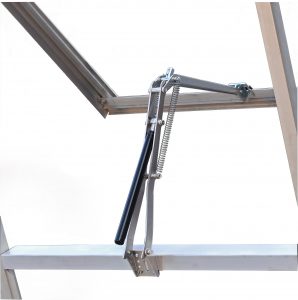
The ideal greenhouse for your vegetable garden
There are different types of greenhouses, each with their own benefits and features. Not sure which greenhouse is best suited for your vegetable garden plans? No problem. To help you get started, here’s a quick overview of all types.
Small or large greenhouse
Which greenhouse you choose depends, of course, on the available surface area. In a large garden you can logically place a larger greenhouse. But do not be discouraged if you have less space: there are also possibilities for a smaller (city) garden, courtyard or terrace. Just look at the ACD® Piccolo P03 of 3.56 m2 or the even smaller wall greenhouse Miccolo M03 with a surface area of 1.85 m2.
There is no real greenhouse for beginners, because it is an investment that you want to grow with you. A durable solution that you choose not only for your hobby today, but also for the future. So it’s better to choose a greenhouse that is a little too big now than a model that over the years will become too small for your vegetable garden plans. Extra interesting: the space in the greenhouse that you don’t currently use can always be used as storage space for garden equipment or as a cosy relaxation corner.
Tip: Don’t just think about growing on the ground, think about vertical gardening. Using hanging pots, shelves, work tables and other accessories, you can create an optimal layout for your greenhouse, even if you choose a smaller model.
Wall greenhouse or freestanding greenhouse
Did you know that in addition to freestanding greenhouses, there are also wall greenhouses? These consist of three instead of four sides and are placed against the facade of your house or an outbuilding. Again, convenient when you have less space and thanks to the connection to your house, it is easier to run water, heating and electricity pipes to your greenhouse. This is not necessary in itself, but it is a welcome extra if you want to provide a tap, lighting or heating element in your greenhouse.
Important: your greenhouse must be firmly planted in the ground. Therefore, choose the right foundation for your greenhouse. This can be a concrete foundation, but even more practical is the self-supporting aluminum foundation that comes standard with your ACD® greenhouse.
Greenhouse with sloping or straight walls
Both wall greenhouses and freestanding greenhouses are available with angled or with straight walls. As a unique concept from ACD®®, greenhouses with angled walls offer some special advantages:
- The sloped walls reduce wind pressure because the wind is better directed over the greenhouse.
- The weight of the roof is better distributed which ensures a more stable construction.
- More and better light, of course, is particularly beneficial for your plants.
Garden rooms
Are you going to use your greenhouse not only for growing, but also as a garden room to enjoy your garden in? Then the ACD® garden rooms are perfect for you. You can create several cozy corners in it to organize a winter barbecue, for example, or cozy reading in the first spring sun. Or choose the Bora Bora model which, in addition to the indoor space, also has a covered lounge.
Please note that a garden room is not the same as a veranda! A veranda is usually built to your house and has insulation. A garden room can also stand alone and is not insulated.
→ Also read: what is a greenhouse?
The orientation of the greenhouse in your garden
Probably you have already picked a spot in your mind that is perfect to place your greenhouse. But have you considered the ideal orientation? First, think about sunlight. You want to create a nice warm climate in the greenhouse for exotic plants, so avoid places with too much shade. Ideally, you should place the greenhouse with the long side facing east and the short side (the one with the doorway) facing south. That way you can take maximum advantage of the rising sun and avoid the too bright southern sun.
Next, take the wind into account. Put your greenhouse in a place that is sheltered, such as where there is a hedge or a wall nearby. An exposed greenhouse cools down too quickly during cold nights and is more susceptible to storm damage.
Since it’s best to visit your greenhouse twice a day in the summer to water your plants, preferably don’t put them too far from your home. The shorter your food chain, the better, right?
What vegetables do you grow in the greenhouse?
In the greenhouse you can grow classic Flemish vegetables such as carrot, onion, chicory and celery. But did you know that a greenhouse is also perfect for growing rather southern vegetables? These plants – such as tomatoes, eggplants and different types of peppers – love the warmth of the sun, and your greenhouse is perfect for that….
In turn, during the colder autumn and winter months, the greenhouse is the ideal place to harvest tasty nutritious leafy vegetables such as lamb’s lettuce and spinach. But certain types of cabbage, leeks and turnips can also do perfectly in the greenhouse.
In addition to vegetables, you can of course grow fruit in the greenhouse. Then choose exotic fruits such as juicy melons, strawberries, grapes and even kiwis. And have you thought about using your greenhouse to grow flowers? The possibilities are endless!
Note: Just like in your vegetable garden, combination growing is important in the greenhouse. In combination growing, you divide your crops into groups based on their reinforcing characteristics. For example, beans, squash and corn make a good trio and basil keeps harmful insects away from your tomatoes. But certain crops can also have an adverse effect on each other. Do plenty of research and always prepare a floor plan for your greenhouse to prevent your plants from hindering each other, making each other sick or creating unwanted pests.
The greenhouse for beginners: facts and tips by season
Ready to get started in your own greenhouse? Find out here how to proceed season by season.
The greenhouse in winter
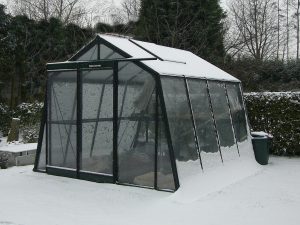
Thought there was nothing to do in the greenhouse in winter? Think again. Because although the winter months in the garden are obviously the quietest, you can already do quite a lot of preparation for the upcoming season.
-
In winter, it’s a good idea to flush your greenhouse. That is, you fill it with water and let that water soak away, filtering out the excess salt. Is it snowing? Then you can also put a layer of snow over the ground for the same effect.
-
Clean the windows and aluminum frame of your greenhouse with water and a little soap to remove moss and chalk.
-
n winter, you can harvest delicious winter vegetables such as celery, Brussels sprouts, cabbage, parsnips, leeks … Want to grow even more in winter? Then you can heat your greenhouse with the Phoenix or Palma heating element from ACD®.
-
Do you have frost sensitive plants on your terrace or in your garden? Then they can overwinter in the greenhouse.
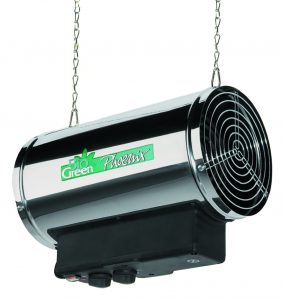
Phoenix – This heater is easy to control and safe to use. With powerful fan, suitable for greenhouses up to 20 m².
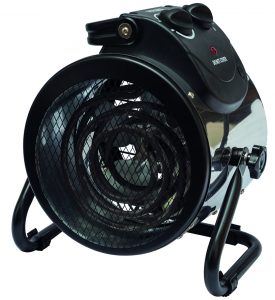
Palma – Despite its compact shape, this stove is very powerful. And most importantly, it looks beautiful. It therefore fits perfectly in your greenhouse, up to 12 m².
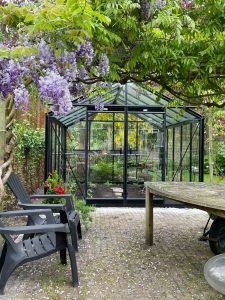
The greenhouse in spring
Nothing like those first rays of spring. Even in the greenhouse everything starts to grow and bloom. Enjoy!
-
Thanks to the protection of your greenhouse, you can start gardening extra early. You can start pre-sowing in your greenhouse in March. Are the temperatures still dropping? Then protect your seedlings with a fleece.
-
Just before you start planting, make sure your soil is well-nourished with a layer of fertilizer and soil conditioner.
-
Warm spring? Then don’t forget to provide adequate ventilation. If necessary, use an automatic window opener that senses for itself when it’s time for some fresh air.
-
Water your plants regularly.
-
In spring you can seed anything from herbs to beet, peas and beans, cabbage crops … Spring is also the perfect time to plant different types of lettuce in the greenhouse.

Summer is the time to enjoy gardening, but also to enjoy your homegrown harvest.
-
A shade cloth in your greenhouse prevents your plants from drying out or getting burnt by the bright summer sun.
-
Watering is even more important in summer. Do that preferably twice a day: once in the morning before it gets hot and once in the evening when it cools down again.
-
Not only water is crucial: regular feeding also does your plants good.
-
Always leave the doors and windows of your greenhouse open during the summer to provide adequate ventilation.
-
Actually, you can sow, plant and harvest various fruits and vegetables all summer long in the greenhouse. From tomatoes to cucumber, spinach, lettuce, strawberries, peppers, cabbages …

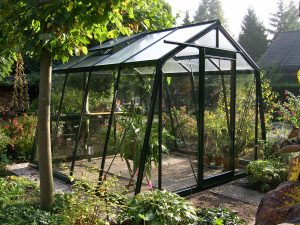
Greenhouse in autumn
-
In autumn you can usually harvest for a long time what you planted in the summer.
-
You can plant cabbage vegetables (such as cauliflower, kale and broccoli) in autumn.
-
Still want to seed in the fall? Then choose crops that are not sensitive to colder temperatures such as winter spinach, purslane and corn salad.
-
Be alert for snails in the greenhouse in autumn!
-
End of the season? Then that’s the perfect time for an autumn cleaning.
Additional accessories and greenhouse supplies
Your greenhouse in itself is one thing, but did you know there are lots of accessories and supplies you can add? For example, you can expand the interior of your greenhouse vertically with shelves, seed tables and work tables. At ACD® you always buy these in a package that includes all the necessary fasteners.
There are also practical tools such as an aluminum ramp. Useful for wheelbarrows, but it also makes your greenhouse accessible for wheelchairs.
Discover the aluminum ramp for greenhouses.
Or how about tomato hooks, a precision thermometer, a watering tray or a drip kit? Whatever you need: we will gladly provide you with it!
Ready to buy a greenhouse? Ask for more info at one of our distribution points or visit our Experience Center in Roeselare. We will be happy to help you choose the greenhouse that suits your garden, personal taste and vegetable garden plans.
